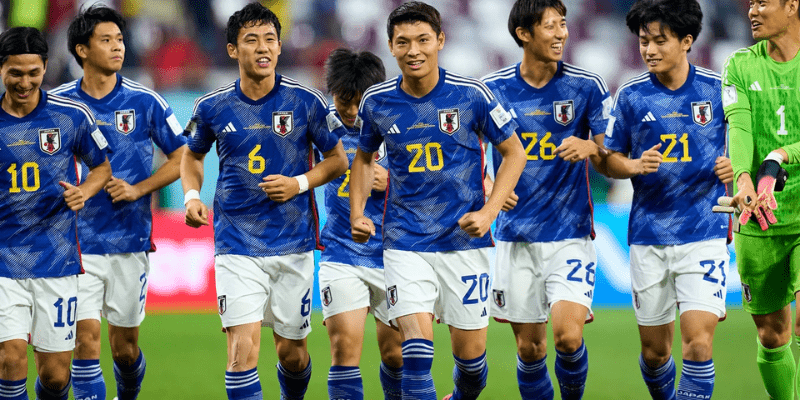When you hear “why is Japan’s national team nicknamed Samurai Blue,” it immediately conjures images of proud warriors draped in blue. It’s more than a catchy label — it’s a story of identity, symbolism, culture, and football evolution. In this article, IndiGoal will dive deep into the origins, meaning, evolution, and impact of the nickname Samurai Blue, and how it connects Japan’s national team to both its historical roots and modern ambitions.
The Origin of the Samurai Blue Nickname

“Samurai Blue” was not always the automatic moniker of Japan’s men’s national team. The term was intentionally crafted, rather than organically emerging.
- In the early 2000s, the Japan Football Association (JFA) sought a way to brand the national team with a name that evoked character, spirit, and a unique identity.
- There was a fan poll ahead of the 2006 World Cup to select, “Samurai Blue” proved to be a favorite and was officially adopted as one of the nicknames for the team.
- The combination is meaningful: “Samurai” references Japan’s warrior heritage — discipline, bravery, honor — while “Blue” refers directly to the team’s primary color in jerseys and kits.
- Over time, the term has merged with the team’s identity so seamlessly that many fans hardly pause to wonder how it came about.
This deliberate branding move tied Japan’s footballing aspirations to an evocative national image — one that resonates domestically and carries meaning on the global stage.
Symbolism Behind “Samurai” and “Blue”
Samurai: More Than Warriors
The samurai class is a powerful signifier in Japan’s cultural memory. These were the elite warriors of feudal Japan, bound by codes of loyalty, discipline (bushidō), and sacrifice. Their image evokes:
- Honor and integrity
- Perseverance under adversity
- A warrior spirit rooted in identity, not ego
By associating the team with “samurai,” the JFA aimed to signal that national team players are modern warriors of the pitch, fighting for pride, legacy, and national honor.
Blue: The Chosen Color
Why “Blue” rather than red and white, the colors of Japan’s national flag? Several reasons stand out:
- Japan’s football teams had already used blue kits in international competition long before the nickname. The blue jersey became strongly associated with the national side and stood out in Asia, where red is more dominant.
- The blue shirt is also seen as a differentiator from rivals like South Korea and China — many Asian teams use red.
- Psychologically, blue often conveys calmness under pressure and composure — qualities desirable in high-stakes football.
- The consistent use of blue across time reinforced the visual identity tied to “Samurai Blue.”
Thus, combining the martial “Samurai” with the evocative “Blue” created a moniker that was both symbolic and instantly recognizable.
Evolution of Samurai Blue in Japan’s Football History

Early Kit Colors and Shifts
The path to “Samurai Blue” wasn’t linear. Japan’s national team kits went through phases:
- In early decades, football in Japan was not professionalized, and kit colors varied with limited significance.
- In international play, Japan sometimes used white base kits with blue trims.
- After disappointing results while using red/white kits in the late 1980s and early 1990s, Japan gradually returned to blue as the primary color — the “blue reign” took firm hold in the mid-1990s.
- As blue became the de facto color, branding and marketing around it strengthened.
Official Endorsement and Branding
As the JFA embraced a more professional and global approach in the 2000s, the nickname took on formal status:
- “Samurai Blue” became an official term in JFA communications and marketing.
- The nickname began appearing on merchandise, jerseys, social media, and fan campaigns.
- The team crest and identity were reworked to match the brand — including the adoption of the mythical Yatagarasu (a legendary three-legged crow) in the emblem, tying football symbolism to Japanese mythology and folklore.
- The name grew organically in usage — fans, media, and commentators all embraced it.
Present Day and Cultural Resonance
Today, the nickname is inseparable from the Japan men’s national team. Every time you see the blue kit on the international stage, “Samurai Blue” is already resonating. The name conveys:
- A sense of unity: players are warriors acting under a unified banner
- A connection to heritage: modern football as an extension of tradition
- A competitive aura: the team is not just “Japan,” but “Samurai Blue,” implying fight, identity, and expectation
Why the Nickname Matters: Beyond a Label
Branding and Global Recognition
In the sea of national team nicknames — e.g. “Seleção” (Brazil), “Three Lions” (England), “Les Bleus” (France) — “Samurai Blue” stands out. It offers:
- A memorable and evocative brand for international marketing
- Strong imagery to attract fans and media coverage
- Merchandise power — jerseys and paraphernalia with “Samurai Blue” have strong appeal
Emotional and Psychological Identity
For players and fans, the nickname carries weight:
- Players represent more than a flag — they carry a symbolic legacy.
- Fans embrace a narrative: they’re supporting not just “Japan,” but the modern samurai of football.
- It helps generate emotional narratives in tournaments, tying modern matches to tradition and national pride.
Unity Across Generations
The moniker is also a bridge across eras. When historical matches are recalled — the 2002 World Cup run, Asian Cup triumphs, shock wins over big nations — they all now sit under the umbrella of “Samurai Blue.” This continuity helps fans of different ages share a collective identity.
Challenges and Critiques of the Samurai Blue Moniker
No symbol is immune to scrutiny. Some critics and observers have raised valid points:
- Overuse or cliché: Repeatedly invoking “samurai” risks drifting into generic “warrior” metaphors common in sports.
- Cultural commodification: A historical, sacred Japanese symbol used for branding can feel commercialized.
- Expectations pressure: The nickname implies a standard of honor and fight; when results fall short, criticism can intensify.
- Uniqueness debate: Other Japanese national teams use different nicknames (e.g. women’s team is called “Nadeshiko Japan”), which raises discussion about consistency.
However, the enduring popularity and acceptance among fans and players suggest that the positives outweigh the critiques.
Samurai Blue in Big Tournaments: Identity in Action
World Cup Moments
Whenever Japan steps onto a World Cup pitch clad in blue, it’s more than color — it’s a declaration. Memorable moments include:
- Shock wins over powerhouse teams (e.g. Germany in 2022) where the “warrior spirit” narrative sharpened the dramatic impact.
- Matches decided on discipline, composure, or resilience — traits aligned with “samurai” ethos.
Asian Cup and Continental Success
Japan is among Asia’s most successful teams, with multiple AFC Asian Cup titles. Each tournament adds layers to “Samurai Blue” lore — victory = validation of identity; setbacks = tests of honor.
Friendlies and Branding Matches
In friendlies — whether charity matches, regional cups, or exhibitions — the branding helps amplify visibility. Fans wear blue gear, chants invoke the nickname, and media often reference it in stories and headlines.
Related Nicknames and Broader Cultural Context
To fully appreciate why is Japan’s national team nicknamed Samurai Blue, it helps to see related usage:
- The women’s national team is known as Nadeshiko Japan, referencing a poetic flower symbolizing the “ideal Japanese woman.”
- In baseball, Japan’s national baseball team is sometimes called Samurai Japan — showing how “samurai” imagery extends beyond a single sport.
- In youth or under-age Japanese football, the “Samurai Blue” label sometimes appears, but it is most strongly associated with the senior men’s team.
These multiple uses show how “samurai” has become a broader symbol of representing Japan in competitive sport.
Future of Samurai Blue: Evolving Legacy

As Japan football continues evolving, several trends may shape how the nickname grows:
- Generational shifts: Younger players may reinterpret what “samurai” means in a modern, multicultural Japan.
- Brand expansion: The nickname may be more heavily leveraged in global marketing, social media campaigns, esports tie-ins.
- Narrative adaptability: New stories of triumph, heartbreak, resilience will add layers to the “Samurai Blue” mythos.
- Fan-led evolution: Supporters may give new chants, slogans, or imagery that reshape what “Samurai Blue” evokes.
Whatever changes come, the core is likely stable: the symbol of Japan’s national team as modern warriors in blue will endure.
Final Thoughts
Why is Japan’s national team nicknamed Samurai Blue? Because it fuses cultural identity, visual symbolism, and brand strategy into a powerful emblem. The name reflects Japan’s warrior heritage, the team’s blue jersey, and a narrative of honor, fight, and unity.
Through Samurai Blue, every match becomes more than a game — it’s a chapter in a broader story of national pride, footballing ambition, and collective identity.
IndiGoal invites you to stay with us: explore player profiles, match reviews, and deeper histories under the banner of Samurai Blue. Journey further into Japan’s football identity —
